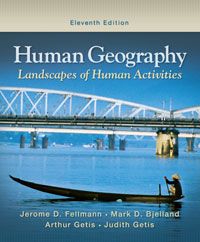1 A) eliminate the hazard. B) make it determinate and knowable. C) move to a less hazardous area. D) deny its reoccurrence. 2 A) east west patterns. B) north south patterns. C) northeast southwest patterns. D) northwest southeast patterns. 3 A) linear miles. B) number of telephones. C) intervening opportunities. D) travel time or cost. 4 A) changes in career course B) changes in life course C) individual personality requirements D) changes in political affiliation 5 A) areas near the point of origin constitute the largest segment. B) the size of the destination is not a factor. C) the movement of retirees to Florida is a good example. D) they are the same as channelized migration flows. 6 A) 12.5 miles from each city. B) 18.3 miles from City 1. C) 28.9 miles from City 2. D) 32.3 miles from City 1. 7 A) a desire to escape war and persecution. B) a higher-paying job in a nearby city. C) overcrowding in major cities. D) reduction of rural farm workers. 8 A) critical distance. B) space-time convergence. C) space-cost convergence. D) time-space prisms. E) distance decay 9 A) distance decay operates more strongly on the Old Order Mennonites. B) Old Order Mennonites are lazier than cash-economy Canadians. C) Old Order Mennonites have a longer critical distance. D) rural cash-economy Canadians like to shop. 10 A) personal business trips. B) school trips. C) shopping trips. D) work trips. 11 A) retirees. B) teenagers. C) the middle aged. D) young adults 12 A) most migration proceeds step-by-step. B) most migrants go only a short distance. C) most migration is urban to rural. D) most migrants are adults. 13 A) the gravity model does not take distance into account. B) the potential model makes no provision for size of places. C) the potential model accounts for interaction between many places, while the gravity model deals with only two places at a time. D) they do not differ at all. 14 A) means of mobility. B) opportunity for interaction. C) stage in the life course. D) strength of territoriality. 15 A) hazardous areas are often residentially desirable. B) hazardous events are relatively rare. C) no information is available about the natural hazards of any location. D) with time, the memory of previous hazardous events fades. 16 A) migrants go from rural areas to central cities in a series of less extreme locational changes. B) an advance group of migrants, once established in a new area, is followed by second and subsequent migrations from the same home district. C) large numbers of migrants return to their place of origin. D) migrants respond to push and pull factors simultaneously. 17 A) complementarity. B) directional bias. C) intervening opportunity. D) distance decay. 18 A) Light truck trips in Chicago have a greater friction of distance than rail shipments in general. B) The cost, by truck, is greater than the cost of shipping by rail. C) The steeper the slope of the interaction curve the lower the friction of distance. D) Volume of interaction decreases with increasing distance. 19 A) airplane B) automobile C) bicycle D) walking 20 A) critical distance. B) directional bias. C) place utility. D) spatial search. 21 A) distance bias. B) network bias. C) directional bias. D) critical distance. 22 A) the desire to find marriage partners. B) push factors associated with civil wars. C) economic pushes and pulls. D) changes in the life cycle. 23 A) the characteristics and value of the product. B) the distance measured, in time and money penalties, over which it must be moved. C) the ability of the commodity to bear the costs of movement. D) the product's ability to meet the different regulatory laws of the areas through which it moves. 24 A) more but shorter trips. B) fewer but longer trips. C) fewer but shorter trips. D) more but longer trips. 25 A) climate. B) standard of living. C) political system. D) unfamiliarity.





